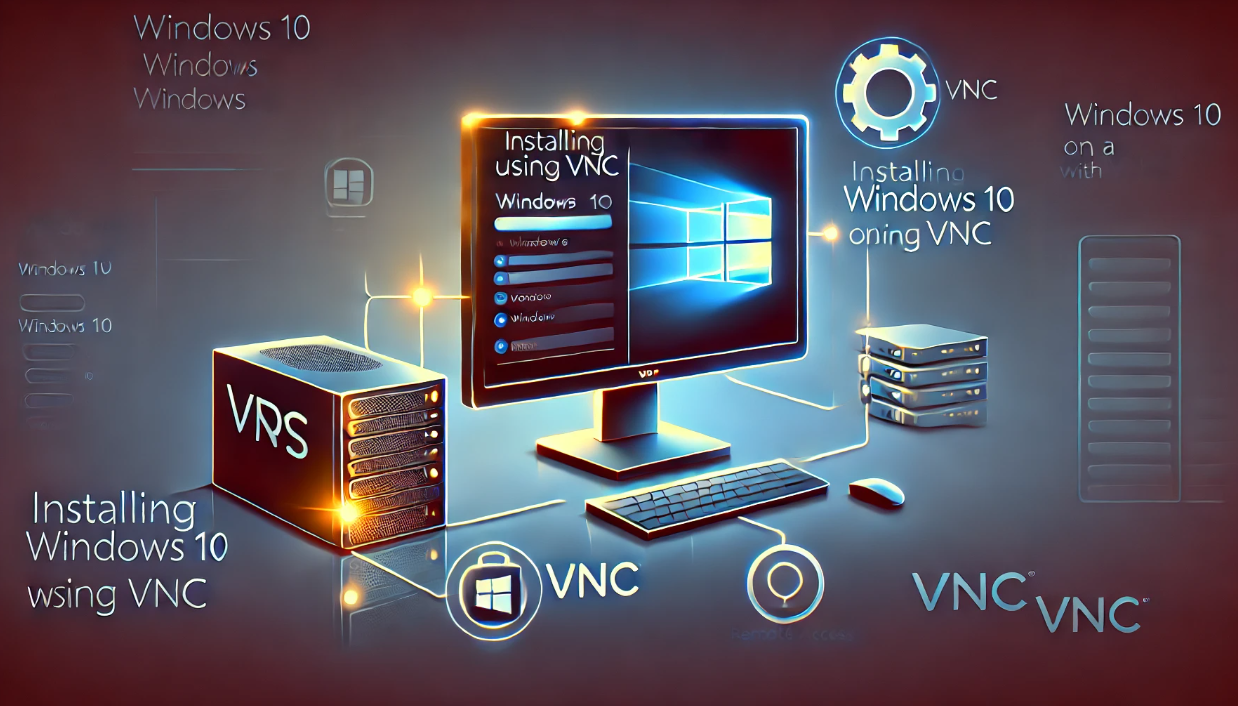Simplest Way to Install Windows 10 on a VPS Over VNC
If you’re looking for a quick and easy method to install Windows 10 on your VPS using VNC, follow this streamlined guide:
Prerequisites
-
A VPS Hosting Service:
- Ensure your hosting provider supports custom ISO installations (check the provider’s documentation or panel features like Virtualizor or SolusVM).
-
Windows 10 ISO File:
- Download the official ISO from Microsoft: Windows 10 Download
Select “Download Tool Now,” and use the tool to create an ISO.
- Download the official ISO from Microsoft: Windows 10 Download
-
VNC Viewer:
-
VPS Minimum Requirements:
- CPU: 2 cores or more.
- RAM: 4 GB or more.
- Storage: At least 30 GB disk space.
Step-by-Step Instructions
Step 1: Upload Windows 10 ISO to VPS
-
Access Your VPS Management Panel:
- Log in to your control panel (e.g., Virtualizor or SolusVM) using credentials provided by your hosting provider.
-
Upload the ISO:
- Navigate to ISO Management or a similar section.
- Upload the ISO from your local device or provide the direct download link
https://software-download.microsoft.com/db/Win10_21H2_English_x64.iso
(Replace with the latest ISO version from the official source.)
-
Verify Upload:
- Once uploaded, confirm the ISO is listed under available ISOs.
Step 2: Create a VPS with the Windows 10 ISO
-
Create a New VPS:
- Navigate to Create VPS or a similar option.
- Assign the uploaded Windows 10 ISO as the bootable media.
-
Allocate Resources:
- Select at least:
- 2 CPU cores
- 4 GB RAM
- 30 GB storage
- Select at least:
-
Network Settings:
- Ensure that the VPS is assigned a public IP address for external access.
-
Finalize VPS Creation:
- Save your configuration and create the VPS.
Step 3: Access the VPS Using VNC
-
Find VNC Details:
- Locate the VNC connection details (IP, port, and password) in the VPS management panel.
-
Install a VNC Viewer:
- Download and install your preferred VNC client:
-
Connect to the VPS:
- Open the VNC client and enter the connection details.
- Use the provided password to start the session.
-
Boot from ISO:
- In the VNC session, confirm that the VPS boots into the Windows 10 ISO. You may need to select the boot device during startup (often done by pressing
ESCor a function key likeF2orF12).
- In the VNC session, confirm that the VPS boots into the Windows 10 ISO. You may need to select the boot device during startup (often done by pressing
Step 4: Install Windows 10
-
Follow Installation Prompts:
- Choose language, time zone, and input method.
- Click “Install Now.”
-
Enter Product Key:
- Enter your Windows 10 license key or select “I don’t have a product key” to activate later.
-
Partition the Disk:
- Choose “Custom Installation.”
- Select the unallocated disk space and let the installer create the necessary partitions.
-
Complete the Installation:
- Set up a username, password, and any additional preferences.
- Wait for the installation to finish.
Step 5: Post-Installation Setup
-
Install VirtIO Drivers (if required):
- If your VPS uses KVM, you may need VirtIO drivers for optimal performance:
- Download VirtIO drivers: VirtIO ISO
- Mount the VirtIO ISO through the VPS panel and install the drivers in Windows.
- If your VPS uses KVM, you may need VirtIO drivers for optimal performance:
-
Network Configuration:
- Verify network connectivity by checking the IP address and testing internet access.
-
Activate Windows:
- Activate Windows using a valid license key.
Step 6: Secure and Optimize the VPS
-
Enable Windows Firewall:
- Go to Control Panel > Windows Defender Firewall > Turn on Firewall.
-
Install Updates:
- Run Windows Update to install the latest security patches and drivers.
-
Set a Strong Admin Password:
- Use a secure password to prevent unauthorized access.
-
Install Remote Desktop or Other Tools:
- If you prefer RDP over VNC for future access, enable it in Windows settings.
Common Troubleshooting
-
ISO Doesn’t Boot:
- Ensure the ISO is selected as the primary boot device in the VPS panel.
-
VNC Connection Issues:
- Verify VNC port is open on the firewall:
sudo ufw allow 5900/tcp
sudo ufw reload
3. Slow Installation Performance:
-
- Check if sufficient resources (RAM, CPU) are allocated to the VPS.
Conclusion
Installing Windows 10 on a VPS using VNC is straightforward with proper planning. By following these steps and ensuring that your VPS resources and tools are in place, you can enjoy a fully functional Windows remote desktop environment for various tasks. Let me know if you need further assistance!

